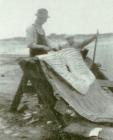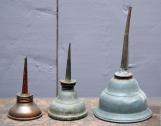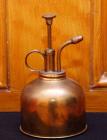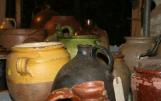1
There was no time to waste; processing belugas immediately after the hunt resulted in higher quality products. After being hauled up onto the bank, they were immediately turned on their backs for cutting. They were cut open from tail to neck using sharp knives. A cut perpendicular to the first cut was made around the head. Skin and blubber were separated from flesh and bones. By the end of this process, a thick coat of blubber remained, attached to the skin on one side, with the beluga carcass made up of flesh and bones on the other. The skin and layer of attached blubber were fixed on to hooks and hauled by horses to the sheds.Preparation for the melting of beluga blubber consisted in separating blubber from skin. To do this, the skin was attached to a beam, blubber side out. One man turned the beam and a second man, holding a very sharp knife, cut the blubber near the skin. This blubber was then cut into pieces measuring 30 cm by 30 cm, which were in turn ground in a grinder made by the Lizottes. The ground up product was then melted in a double boiler. This final step is what set Joseph and Émile Lizotte's oil apart from the rest. Blubber melted directly over a fire produced lower quality oil.
Blubber from the jaws and melon, the frontal part of the beluga, as well as from a thin layer directly touching the skin, were melted in a shed reserved for white oil, or head oil. This was premium oil. The blubber from other parts of the beluga was processed in a shed used for brown oil, which was of lower quality.
One of Émile Lizotte's sisters, Théodora, helped in her own way. She "kept the books" for her father. In her memoirs, she also wrote that the lean meat was made into "cretons" for the pigs on the family farm.
2
Beluga fishery employees stripping a mammal of its blubberAround 1920
Pointe de la Rivière Ouelle, Rivière-Ouelle, Quebec, Canada
 Credits:
Credits:Centre d'archives de la Côte-du-Sud
Collège de Sainte-Anne-de-la-Pocatière collection (F100/728/10/13)
Unknown photographer
Émile Lizotte (1902?1988)
3
Workers start cutting up belugas, even before all are on the beachAround 1920
Pointe de la Rivière Ouelle, Rivière-Ouelle, Quebec, Canada
 Credits:
Credits:Almanach de l'Action sociale catholique, 6th year, 1922
4
Carving up a beluga using knives and iron hooksAround 1925
Pointe de la Rivière Ouelle, Rivière-Ouelle, Quebec, Canada
 Credits:
Credits:Paul-Henri Hudon, Rivière-Ouelle, 1672?1972, 1972
Photograph: Fernand Bérubé, priest
5
Men looking at belugas stripped of their skin and blubberAround 1930
Pointe de la Rivière Ouelle, Rivière-Ouelle, Quebec, Canada
 Credits:
Credits:Archives nationales du Québec (Communications collection)
Unknown photographer
6
Gaff head1930s
La Pocatière, Quebec, Canada
 Credits:
Credits:Musée François-Pilote
Photograph: Judith Douville
7
The two buildings in which beluga blubber was melted, and the stable in the background21 May 1929
Pointe de la Rivière Ouelle, Rivière-Ouelle, Quebec, Canada
 Credits:
Credits:Centre d'archives de la Côte-du-Sud
Collège de Sainte-Anne-de-la-Pocatière collection (F100728/10/15)
Unknown photographer
Émile Lizotte (1902?1988)
8
Beam similar to the one used by Émile Lizotte to separate blubber from skin20th century
Pointe-Lebel, Quebec, Canada
 Credits:
Credits:Vladykov, Vadim-D. "Études sur les mammifères aquatiques." Montreal, Université de Montréal, 1944
Photograph: Bonin & Vladykov
Émile Lizotte (1902?1988)
9
Belugas on the shore before being cut upAround 1925
Pointe de la Rivière Ouelle, Rivière-Ouelle, Quebec, Canada
 Credits:
Credits:Centre d'archives de la Côte-du-Sud
Collège de Sainte-Anne-de-la-Pocatière collection (F100/728/10/12)
Unknown photographer
Émile Lizotte (1902?1988)
10
Both in the times of the first settlers and in Émile Lizotte's era, from 1915 to the end of the 1930s, beluga oil was widely used. It was the golden age of the oil from the little white whales. Head oil was reserved for more worthy uses: cooking and lubricating small mechanisms (watches, clocks, chronometers, etc.). Colourless and odourless, it cost more than brown oil, which was used more for tanning and maintaining leather, greasing large gears and lighting.The oil was sold in 100-gallon barrels, mainly to general merchants and manufacturers. Joseph Lizotte and his son Émile had customers in Canada, the United States and even England. The products sold were transported by schooners, trains or boats that could cross the Atlantic. Beluga oil and skin required several hours of hard labour before leaving Rivière-Ouelle.
After the thick layer of fat was removed, beluga skin was soaked before being salted. Preserved in salt and placed in a wooden crate or a barrel, it could be stored for more than a year before being tanned. The leather made from beluga skin was known for its strength, although it tended to stretch when wet. This material was used to cover suitcases, trunks and the canopies of horse-drawn carriages. It was also used to make boots, shoes and clothing, as well as harness straps and for strops to sharpen razors. Laces made from beluga leather were reserved for hardy footwear.
In Europe, particularly England, beluga leather was very popular. In Quebec, it never became popular enough to break into the market and be tanned on a large scale. Products sold by merchants under the name "porpoise leather" were actually made of beluga leather, but few customers knew this.
Necessity brought about invention and the residents of Rivière-Ouelle collected certain beluga bones. It would have taken more than one man working for several days to bury a beluga carcass. Since the beluga fishing buildings were isolated at Pointe de la Rivière Ouelle and the area had not yet been established as a holiday destination, Joseph Lizotte left the unprocessed remains to decompose in the open air.
11
Oil cans of various sizes for lubricating delicate mechanismsAround 1925
La Pocatière, Quebec, Canada
 Credits:
Credits:Photograph: Judith Douville
Émile Lizotte (1902?1988)
12
Valved oil can made of copper1920s
La Pocatière, Quebec, Canada
 Credits:
Credits:Photograph: Judith Douville
13
Earthenware containers for storing oil and food18th to 19th century
Saint-Jean-Port-Joli, Quebec, Canada
 Credits:
Credits:Exhibition: Pottery and earthenware from the French regime to the 20th century
Collection: Raynald Saint-Pierre
Photograph: Judith Douville
14
Oil lampsFirst third of the 20th century
La Pocatière, Quebec, Canada
 Credits:
Credits:Musée François-Pilote
Photograph: Judith Douville